
The Dollar Wrecking Ball: Why is a strong US dollar so dangerous?
The rising US dollar strength is starting to produce cracks across economies and markets.
It has been four months since the colossal explosion of Terra, which saw $40 billion of wealth evaporate in just one week. The project was a big success story of the 2020/2021 bull market after it climbed to the top 10 cryptocurrencies by market cap. The protocol aimed to create an algorithmic seignorage stablecoin:
Most stablecoins, like Tether (USDT) or Circle (USDC), hold their pegged value by being 1:1 backed by real-value assets like fiat currency, liquid, safe assets (US treasury bonds), precious metals or cryptocurrencies. These assets are considered safer because their chance of crashing down is lower. Algorithmic stablecoins are a different beast. These projects use an algorithm to maintain the peg. UST (developed by Terra) was a seignorage algorithmic stablecoin. It used a mint/burn multi-coin mechanism, which mints or burns one of the coins (LUNA) to stabilize the value of the other (UST). Algorithmic stablecoins are still a more or less technological experiment.
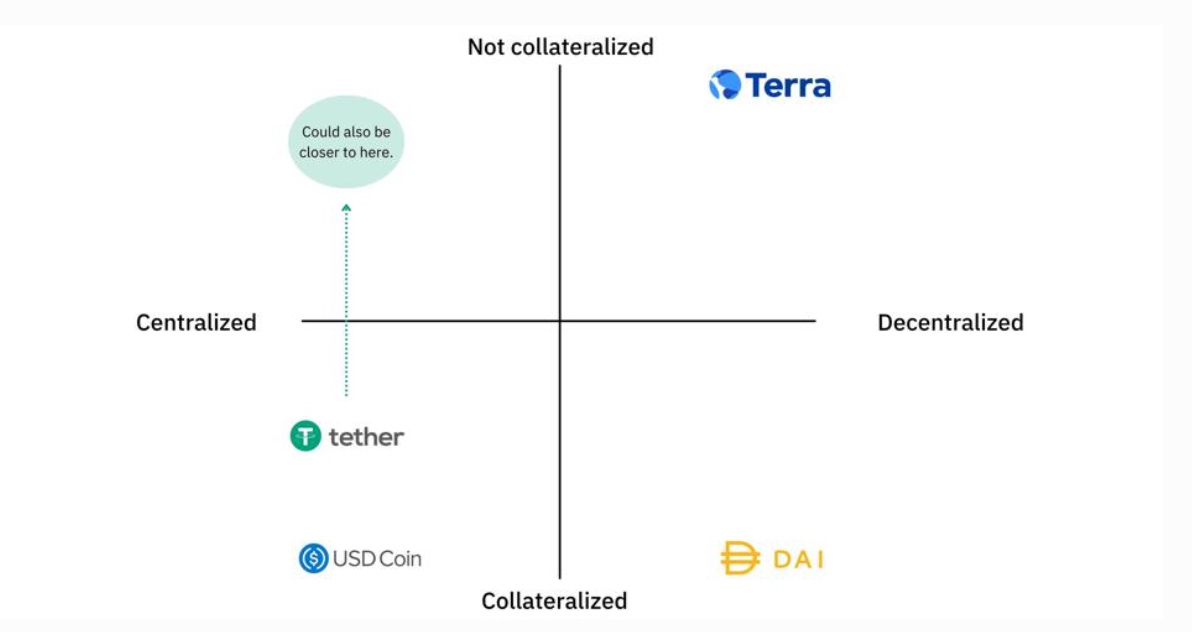
Adoption of UST was rapid, and it quickly rose to the third most-used stablecoin. Its twin token, Luna, also saw vast capital inflows, and from August 2020 to April 2022, it surged from $0.5 to its peak of $120 (that’s 24000% in less than two years). In the figure below, you can see the mechanism behind the peg of the UST coin. It was solely based on an arbitrage system, which created incentives for arbitrageurs to keep the peg stable at 1$.
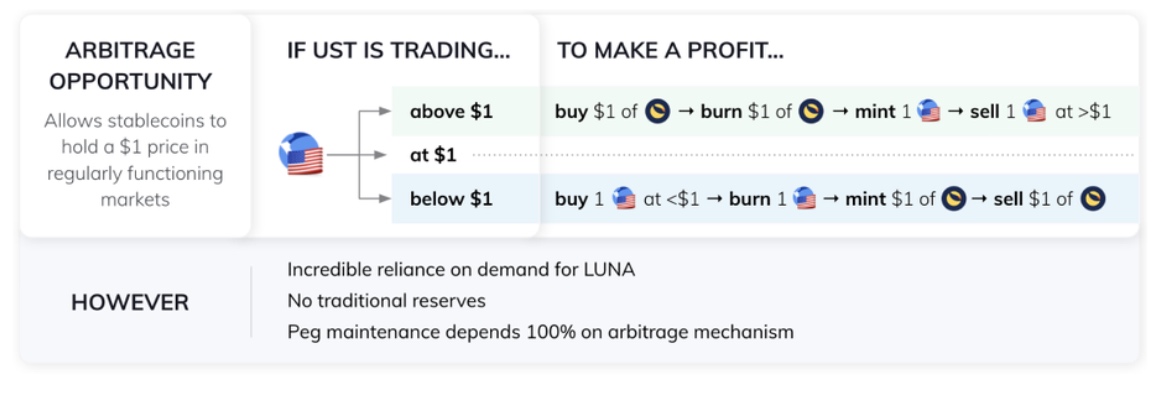
However, starting on May 7th, a supposed attacker made a large sale of $350 million of UST, which caused an imbalance between UST and LUNA, and the stablecoin de-pegged for the first time. People became nervous and started cashing out from UST to other available coins. Arbitrageurs started viciously selling LUNA to stabilize the peg, which consequently sent the price of LUNA into a freefall. The selling compounded uncontrollably, and the protocol entered a “death spiral”.
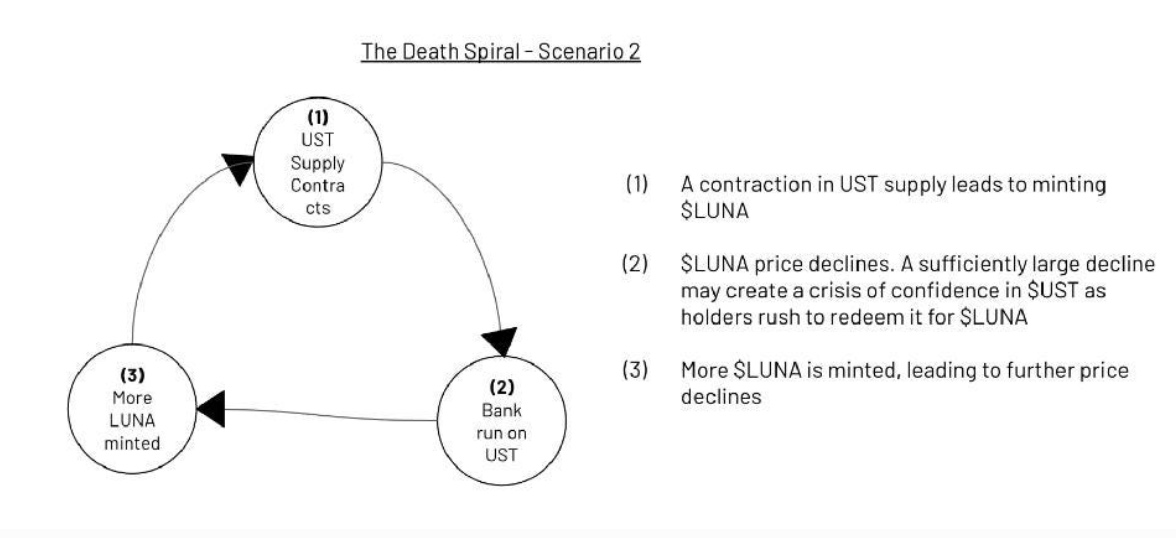
By May 12th, the UST coin lost its peg by more than 80%, and LUNA came crashing down to be worth only a fraction of a dollar. The collapse sent shockwaves across the crypto sector, resulting in several bankruptcies (Three Arrows Capital, Celsius, Voyager, et cetera). Projects built on LUNA fled and looked for a new home (mostly landing on the Polygon chain). Countless investors lost their life savings, and when the dust settled, $40 billion of value evaporated. So, what exactly happened to the defunct project in the coming months after the collapse?
Luna 2.0 (LUNA) and Luna Classic (LUNC)
Following the crash, Terra founder, Do Kwon, proposed a plan to revive the ecosystem. The idea was to do a hard fork of the Luna blockchain and create a new chain called Luna 2.0 while leaving the other one behind. The blockchain underwent the fork on May 28th and the new chain, Luna 2.0, took over the LUNA ticker. The older chain was named Luna Classic (LUNC). The project then used an airdrop to give new tokens to users who were left holding any LUNA or UST following the downfall. The idea was that all the users would then migrate to the new chain, where the team would build a new Layer-1 ecosystem. The desperate investors had no other choice but to accept the tokens and hope the team can miraculously turn things around.
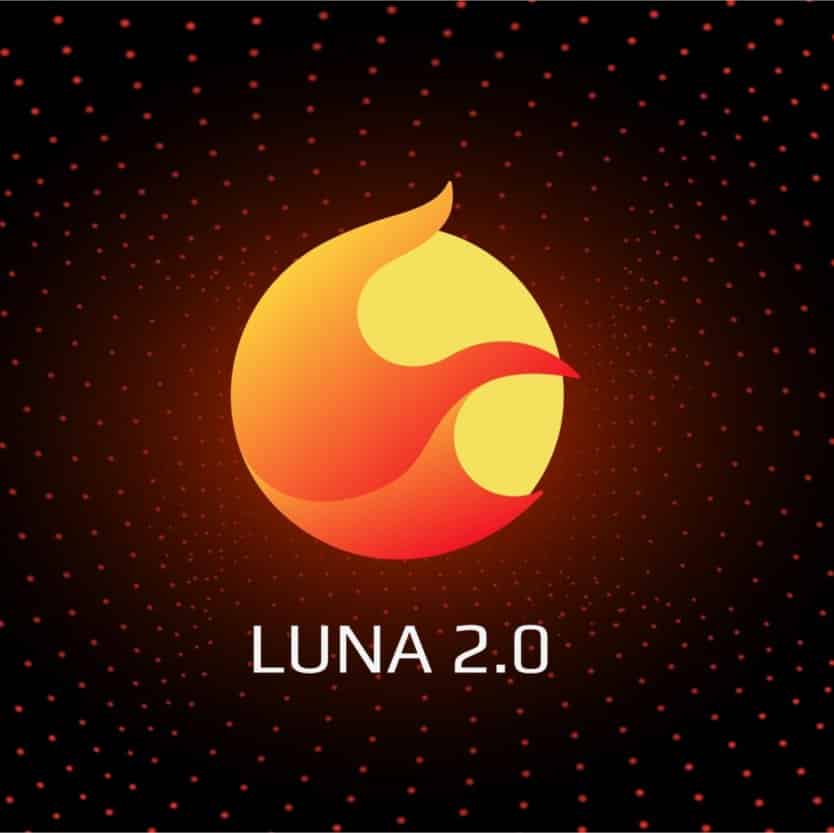
The other chain, Luna Classic (LUNC), was left behind by the team, mainly because it was damaged beyond repair due to the hyperinflation of its tokens that occurred during the crash. The expectation was that the protocol would slowly dissolve as users migrate to the new chain. However, quite a lot of people actually stayed on the LUNC blockchain, created a community, and aspire to revive the near-dead project.
Although both protocols have been trying to get back on their feet, the overall investor sentiment remains abysmal.
So, why did both chains rally by more than 400%?
The answer would be a mix of desperate investors, headlines and a flood of speculation.
The new Terra project has seen a series of new developments over the past month. Two weeks ago, the Terra Foundation announced a second airdrop of 19 million LUNA tokens. Next, the team created Terra docs, which are supposed to help developers navigate around the network and includes detailed tutorials. Its official webpage has also undergone a rebrand.
The second version of an NFT marketplace called Random Earth was launched on September 14th. Compared to its previous version, LUNA 2.0 did not release a twin algorithmic stablecoin; for obvious reasons. However, they unveiled a new, over-collateralized, fully decentralized stablecoin called SOLID.
The headlines had spurred a spike in the price of LUNA, which, coupled with speculation, brought the price to unreasonable highs. Unsurprisingly, the burst of optimism quickly dissipated, and the price fell back to the lows. It serves as a solid warning to be extremely cautious around projects with issues like Terra.
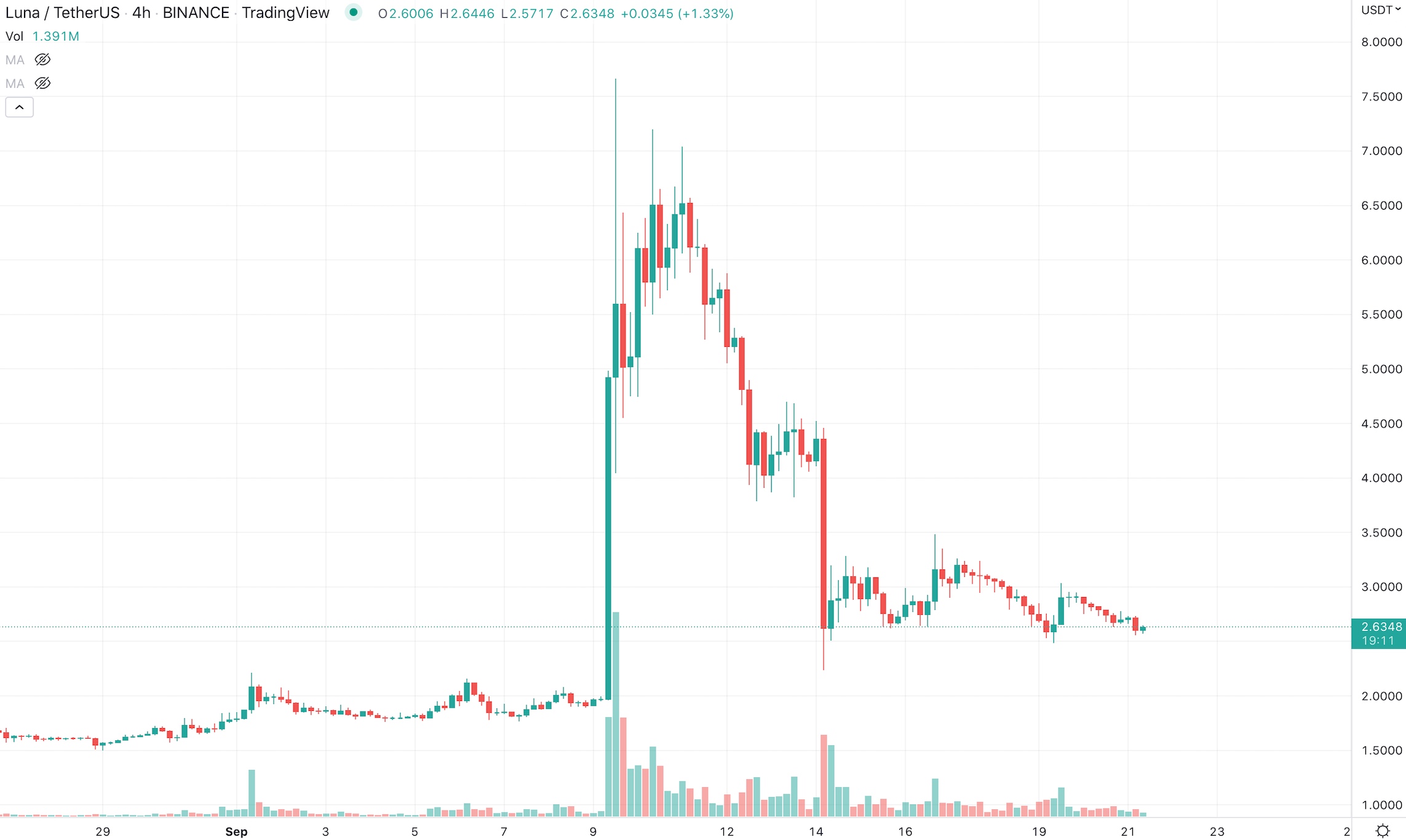
Understandably, without a team of developers behind it, LUNC is not able to bring in as many developments as its new counterpart. However, the community started from the ground by trying to fix its massive coin supply through a burn tax which will automatically burn 1.2% of LUNC off each transaction. The news made LUNC rally alongside the LUNA token. The chart of LUNC looks healthier, but the move still faded and seems to have been spurred mostly by speculation.
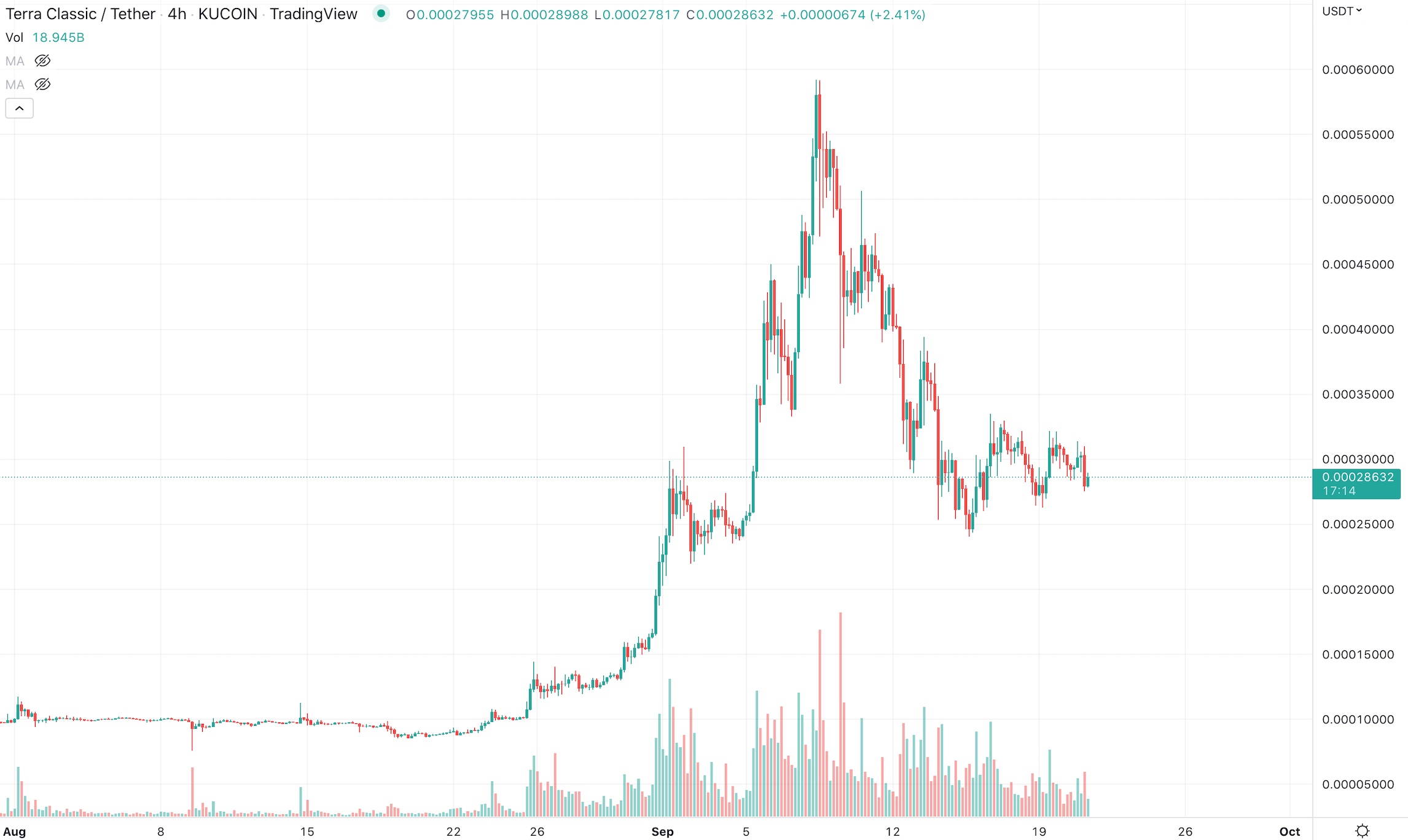
Though it is nice to see both projects making headways and trying to get back on their feet, these are still only baby steps. LUNC remains a protocol with a broken, hyperinflated stablecoin, and LUNA is currently still just plans on paper. Users, investors, and entrepreneurs remain sceptical about the safety and reliability of either project. Moreover, the new Terra project must overcome an additional hurdle. Even if the project were to somehow rise from the ashes, the team of developers, with Do Kwon at the top, has probably tainted its reputation beyond repair.
Do Kwon has always been an overlooked red flag
At first, hailed as one of the most promising figures in the crypto industry, Do Kwon is now compared to the likes of Elizabeth Holmes, suspected of fraud and of deceiving users.

During Terra’s rising popularity, Kwon was able, mainly through being active on Twitter, to gather quite a fandom under his name. Dazzled by the cult of personality built around his name, Kwon missed several warning signals on the way to Luna’s eventual demise. Numerous analysts and crypto developers identified that a malicious user with a large enough capital could start a death spiral. One such user wrote a thread in November 2021, clearly detailing how the protocol could be manipulated into a hyperinflationary collapse. However, Do Kwon recklessly disregarded the opinion and called it “the most retarded thread I have seen in a decade”. In 2022, more analysts joined to point out the potential fragility of the UST peg. Instead of examining the issue more closely, he called the analysts “idiot, stupid and dumbass”.
In hindsight, analysts claim that Terra was not a novel or sophisticated idea. Kwon basically copy-pasted the tokenomics and structure of similar, failed stablecoin projects. Former Terra employees even secretly revealed that Kwon was behind another failed stablecoin project, Basis Cash. The project had launched before Terra was born, and it had been a swift failure as the coin was not even able to achieve parity with the US dollar. Basis cash had two anonymous founders called “Risk and Morty”. Former employees state that Kwon was behind the Rick pseudonym.

Join us right now >>> REGISTRATION
Some argue that Terra was always destined to fail; it managed to survive for so long only because it was functioning during a strong bull market with plentiful liquidity. The reason why the project gained so much traction and popularity compared to other algorithmic stablecoins is that Kwon was able to get funding from the most prominent names in the crypto venture industry. Blind-sided by the rising popularity of its founder, all these entities forgot to properly analyze the fundamentals of the protocol.
However, it is worth noting that despite all his negative attributes, Kwon was strongly dedicated to his business and truly wanted Terra to succeed. The Terra Foundation spent billions of dollars trying to defend the peg when the coins had been plummeting, though unsuccessfully. Even right now, he is trying to revive the project, and as we mentioned above, some new developments are already popping up.
It will still require a lot of work if Kwon wishes to fix his persona. The fact that he became publicly silent following the crash did not help because that was exactly the time when investors demanded the most answers. The only time he came forward was during an interview with Coinage. However, the response was not very positive as he came across as unapologetic and unsympathetic. Moreover, the whole team is expected to be drowning in lawsuits soon. Just a couple of days ago, South Korean authorities issued an arrest warrant against Do Kwon. They even went as far as to ask Interpol to issue a red notice on the founder, as he is nowhere to be found. Meanwhile, Kwon tweeted he is not on the run and is fully cooperating with the authorities. With the threat of prosecution hanging above their head, it will be challenging for the team to focus on bringing the project back to life.

Bottom Line
Though it is cheerful to see both projects trying to turn things around, the fact remains that Luna, along with its UST stablecoin, destroyed an immense amount of wealth. It seems very unlikely that investors or developers would be keen on returning to a project that failed in such a colossal manner. It can be compared to buying a house that just burned down to the ground or paying money for something that largely remains on paper. Hence, it is impossible to see how investors would start trusting the project again. Especially when the crypto sector offers such a competitive space with innovative Layer-1 blockchains and functional stablecoins.
We have seen the price of both projects rise in the last couple of weeks. However, the spikes were probably just a mix of speculation and hopeful buying of desperate investors who lost a fortune in the project. Until either protocol sees true adoption from users or developers, we should regard every price rise as such.
Comments
You must be logged in to add a comment.